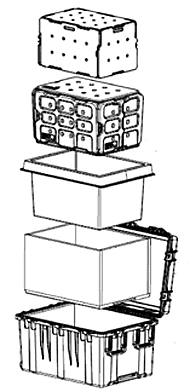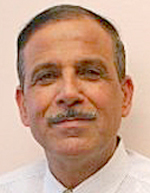 The Phase Change Matters e-mail newsletter is a weekly summary of the latest news and research on phase change materials and thermal energy storage. To subscribe, visit www.puretemp.com/subscribe. For more frequent updates, follow @puretemp on Twitter or visit the Phase Change Matters blog, www.puretemp.com/pcmatters.
The Phase Change Matters e-mail newsletter is a weekly summary of the latest news and research on phase change materials and thermal energy storage. To subscribe, visit www.puretemp.com/subscribe. For more frequent updates, follow @puretemp on Twitter or visit the Phase Change Matters blog, www.puretemp.com/pcmatters.
REQUEST FOR PROPOSALS
Up to $55 billion available in energy savings performance contracts
The Department of Energy is seeking proposals for the implementation of energy savings performance contracts at any U.S. government site worldwide. Up to $55 billion is available, spread across 12 “indefinite delivery, indefinite quantity” contracts. Thermal energy storage is among the project categories. Reed Smith offers an excellent overview of the opportunity:
“Although bidding is limited to energy service companies … this is still a great opportunity for teaming and/or subcontracting and financing some of the most innovative projects of this decade. With smaller government spending and more focus on holding contractors accountable, DOE’s ESPC program may be a blueprint for government contractors moving forward.”
INDUSTRY RESEARCH
Dutch lead project exploring use of PCMs to improve industrial efficiency
A consortium led by the Energy Research Centre of the Netherlands (ECN) is working to develop industrial heat storage applications using phase change materials. The two-year LOCOSTO project is focusing on the application of new PCMs with a substantial heat storage density at temperatures between 100° C and 250° C.
Participants include end users Dow Chemical and Emmtec Services, engineering consultant DWA, system supplier Bronswerk Heat Transfer and materials suppliers Nedmag, Salca and Croda.
PATENT APPLICATION
 Thermal management system with PCM liner, panels
Thermal management system with PCM liner, panels
U.S. patent application 20150068242 [Pelican BioPharma, applicant]:
“A thermal management system includes a case; an insulation material provided within the case, the insulation material defining an interior volume of the insulation material; a liner arranged in the interior volume, the liner having an inner surface that extends toward a center of the case; an outer container of phase change material provided in the liner, the outer container comprising a plurality of outer panels containing a first phase change material, the plurality of outer panels comprising a bottom outer panel, a top outer panel, and side outer panels; and an inner container of phase change material provided in the outer container, the inner container comprising a plurality of inner panels containing a second phase change material; wherein an outer surface of each of the side outer panels is parallel with the inner surface of the liner.”
THERMAL ENERGY STORAGE
Gainesville library adding ice-based energy storage system
The county library in downtown Gainesville, Fla., is replacing its existing 195-ton chiller with a high-efficiency 130-ton chiller and five thermal energy storage tanks. The tanks will be used to collect and freeze water during off-peak hours, when electricity is cheaper. The ice will then be used to chill the building’s air-conditioning system during the day. The CALMAC system is projected to save the county about $40,000 a year in energy costs.
COMPANY NEWS
Thermal storage expert joins Entropy Solutions board of advisors
 Lucas B. Hyman, an internationally renowned authority on thermal energy storage, has joined Entropy Solutions Inc.’s board of advisors.
Lucas B. Hyman, an internationally renowned authority on thermal energy storage, has joined Entropy Solutions Inc.’s board of advisors.
Mr. Hyman, founder and president of Goss Engineering Inc. of Corona, Calif., is a LEED-accredited mechanical engineer with more than 30 years of experience. His clients have included major universities, government agencies, schools, hospitals, industrial facilities, the military and private firms. He is the author of two books, “Sustainable On-site CHP Systems” (McGraw-Hill, 2009) and “Sustainable Thermal Storage Systems” (McGraw-Hill, 2011) and has published a number of papers and articles.
Pluss Polymers seeks funding to help launch new products
Pluss Polymers, a New Delhi-based maker of phase change materials and specialized polymers, is seeking to raise additional funding to help introduce new products, including a low-cost solar drier designed for small farms.
“We are looking at raising another round of funding that should be complete in six to eight months. It would help us bring out newer products. The company is also looking at entering the retail, pharma transport and building market this year,” Samit Jain, business development director, told India’s Financial Chronicle.
RESEARCH ROUNDUP
From International Journal of Thermal Sciences:• Thermal properties of n-pentadecane, n-heptadecane and n-nonadecane in the solid/liquid phase change region
From Applied Thermal Energy:
• Parametrical analysis of latent heat and cold storage for heating and cooling of rooms
From Renewable and Sustainable Energy Reviews:
• Phase change materials for photovoltaic thermal management
From Journal of Building Engineering:
• Analysis of energy requirements versus comfort levels for the integration of phase change materials in buildings
From American Society for Engineering Education:
• Thermal Energy Storage for Building: Thermodynamic and Heat Transfer Analysis for Integration of PCMs in Building Walls
From Energy Technology:
• The Preparation and Characterization of Chitosan–Gelatin Microcapsules and Microcomposites with Fatty Acids as Thermal Energy Storage Materials
From Applied Energy:
• Net energy analysis of a solar combi system with Seasonal Thermal Energy Store
• Application of PCM underfloor heating in combination with PCM wallboards for space heating using price based control system
• Thermal conductivities and characteristics of ternary eutectic chloride/expanded graphite thermal energy storage composites
From Materials Sciences and Applications:
• Preparation of Microcapsules Containing Phase Change Material and Silicon Carbide Powder with Interfacial Polycondensation Reaction Method [pdf]
From Energy Conversion and Management:
• Preparation and thermal properties characterization of carbonate salt/carbon nanomaterial composite phase change material
From International Journal of Heat and Mass Transfer:
• Close-contact melting in a horizontal cylindrical enclosure with longitudinal plate fins: Demonstration, modeling and application to thermal storage
• A similarity solution to unidirectional solidification of nano-enhanced phase change materials (NePCM) considering the mushy region effect
WEEKLY Q&A

Got a question about PCMs or TES? Ask our expert
Dr. Mohammed Farid, an Entropy Solutions advisor and professor of chemical and materials engineering at the University of Auckland, is pleased to answer your questions about phase change material and thermal energy storage. We’ll select the best questions sent to inquiries@entropysolutionsinc.com and post the answers here each Friday.
Sankalp Arpit, a junior research fellow at the Indian Institute of Technology in Mumbai, asks:
“I am working on phase change material in which I am doing characterization. I am getting melting point as 168 degree Celsius in DSC. When I am keeping it in quartz glass by increasing its volume, and I am keeping it in furnace and I am also attaching thermocouple to it and I am measuring it by data logger, then I am getting 179 degree Celsius. Which is the correct method?”
Dr. Farid’s reply:
“There is no melting point but rather a melting range since these are not pure compounds. I assume you are referring to the start of the melting. If the DSC is done at a very low heating rate, such as 1°C/minute, then the measurement should be accurate but not if the heating rate is high. If the sample is placed in an oven and heated very slowly then that the measured melting point is correct, especially if a clear constant temperature is observed during melting.”
NETWORKING
Connect with PCM experts and industry leaders on LinkedIn
More than 100 of your colleagues worldwide have joined a new LinkedIn group devoted to the discussion of phase change material and thermal energy storage. The Phase Change Matters group is intended to be a highly interactive complement to the blog and newsletter of the same name.
You are invited to join the discussion. The first topic is off-peak cooling:
TES pioneers like CALMAC and Ice Energy have been installing ice-based energy storage systems for years. And district cooling has been around for decades. What are the main barriers to wider adoption of phase change material in these types of thermal energy storage systems? Complexity? Education? Cost?